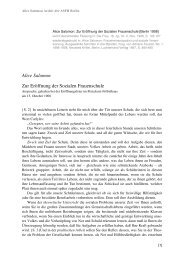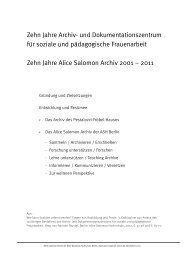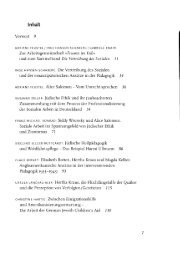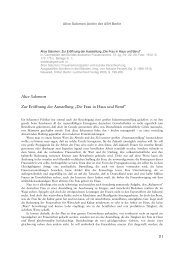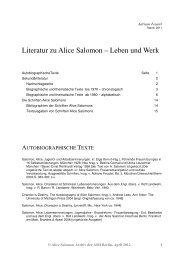Teaching Gender in Social Work - MailChimp
Teaching Gender in Social Work - MailChimp
Teaching Gender in Social Work - MailChimp
You also want an ePaper? Increase the reach of your titles
YUMPU automatically turns print PDFs into web optimized ePapers that Google loves.
Media and popular discourse analysis is an important tool when<br />
exam<strong>in</strong><strong>in</strong>g social policy and visual culture. Anna Szorenyi, 11 <strong>in</strong> her study of the<br />
photographic representation of refugees <strong>in</strong> ‘coffee-table books’, considers the<br />
practice of fram<strong>in</strong>g and thus <strong>in</strong>flect<strong>in</strong>g the mean<strong>in</strong>gs of the images. Szorenyi<br />
argues that while some <strong>in</strong>dividual images offer productive read<strong>in</strong>gs that<br />
challenge stereotypes of refugees, the format of the collections and the accompany<strong>in</strong>g<br />
written text work to produce spectacle rather than empathy, because<br />
they implicitly propagate a world view divided along imperialist l<strong>in</strong>es, <strong>in</strong> which<br />
the audience is expected to occupy the position of privileged view<strong>in</strong>g agent<br />
while refugees are positioned as viewed objects.<br />
As M. Banks suggests, “When study<strong>in</strong>g visual representations that have<br />
been created by others, the dual strands of content and context are fairly easy to<br />
<strong>in</strong>vestigate <strong>in</strong> tandem”. 12 This is very important to remember especially when<br />
the visual representations are produced by the <strong>in</strong>vestigator. 13 A good example of<br />
present<strong>in</strong>g their own visual project is given by Gwen Ellis and Mike Garland, 14<br />
who are social work practitioners <strong>in</strong> New Zealand. They explore the joys and<br />
pitfalls of ventur<strong>in</strong>g <strong>in</strong>to video production as a medium for creat<strong>in</strong>g a teach<strong>in</strong>g<br />
and learn<strong>in</strong>g resource for social work, while provid<strong>in</strong>g practical tips and <strong>in</strong>sights<br />
and demystify<strong>in</strong>g the tasks and term<strong>in</strong>ology associated with video production.<br />
A video teach<strong>in</strong>g resource was created to present family work skills from a<br />
range of cultural perspectives. The core themes <strong>in</strong> this reflection upon the process<br />
and results of the project work are the follow<strong>in</strong>g: pre-film<strong>in</strong>g; film<strong>in</strong>g;<br />
post-production; and market<strong>in</strong>g. In particular, they reflect upon the value of<br />
collaboration between educators and practitioners <strong>in</strong> meet<strong>in</strong>g identified needs.<br />
Visual representations produced by students are important tools for engag<strong>in</strong>g<br />
each member of the group <strong>in</strong> the process of creative and critical reflection.<br />
11<br />
Anna Szorenyi, “The images speak for themselves? Read<strong>in</strong>g refugee coffee-table books,” Visual studies 21, no. 1,<br />
(April 2006): 24-41.<br />
12<br />
Marcus Banks, “Visual research methods,” <strong>Social</strong> Research Update, no. 11 (W<strong>in</strong>ter 1995) available at http://sru.<br />
soc.surrey.ac.uk/SRU11/SRU11.html.<br />
13<br />
See also Banks, 2001.<br />
14<br />
Gwen Ellis and Mike Garland, “The mak<strong>in</strong>g of ‘Home Improvements’ - tools for work<strong>in</strong>g with families <strong>in</strong> Aotearoa/<br />
New Zealand’. Reflections on creat<strong>in</strong>g a video resource for teach<strong>in</strong>g purposes,” <strong>Social</strong> <strong>Work</strong> Education 19, no.<br />
4, (2000): 403–408.<br />
64



